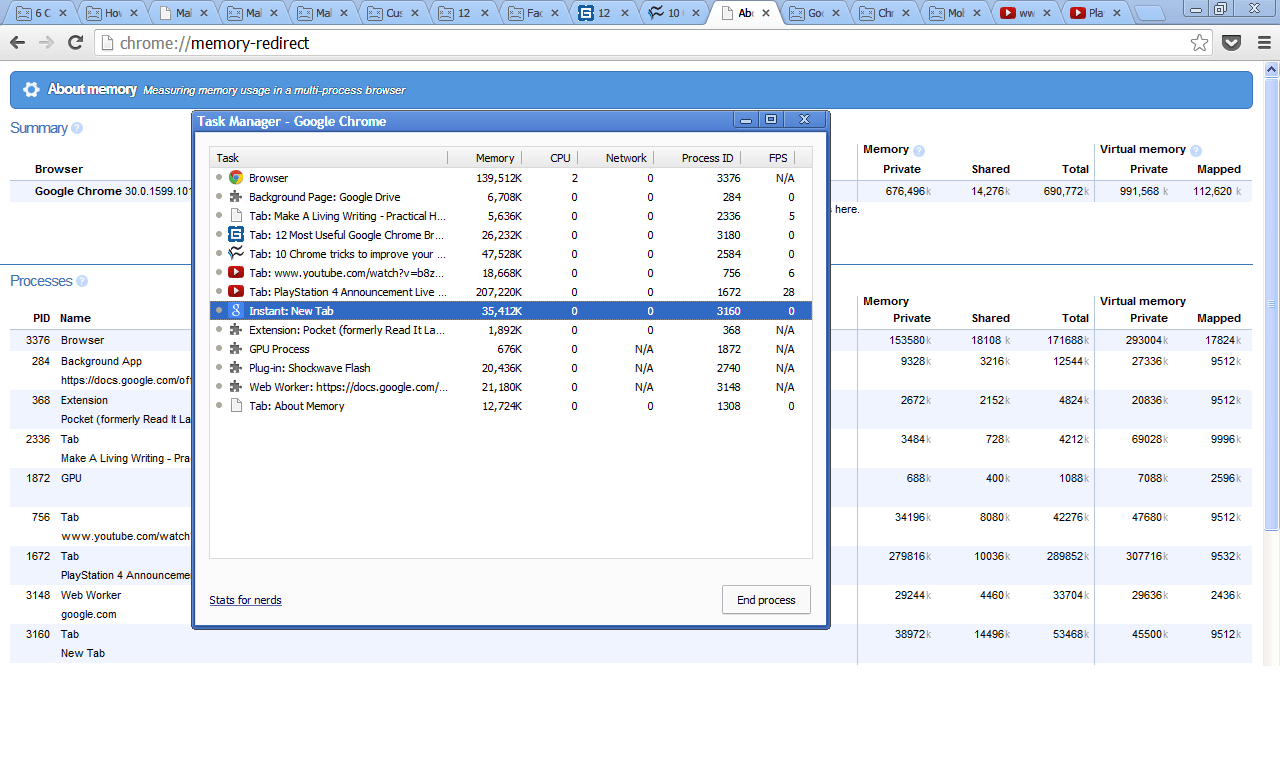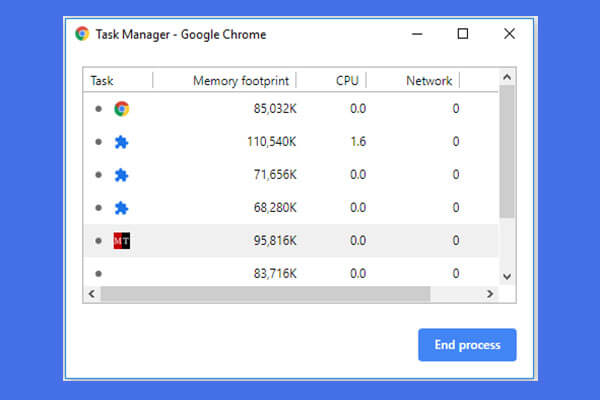- Chrome Task Manager Shortcut
- Chrome Task Manager Cpu
- Chrome Task Manager Freeze
- Chrome Task Manager Subframe
- Task Manager Google Chromebook
- Chrome Task Manager Mac
When checking task manager, Windows is showing multiple chrome processes as open. After closing one or two, the rest of them seem to close automatically. After testing again, Chrome will open. Try Restarting your PC then Chrome. The first, simple fix would be trying to restart. Its been a week in my end, it seems its has been forced another process on this update now, a year ago 'network service' was added to the chrome's taskmanager, then couple of months ago the,'audio service' and now the 'spare renderer', tried to end spare renderer's process but its coming back when i open new tab or open youtube related tabs, devs likes to add something on the taskmanager. I’m using Chrome on Windows 8. I cannot end chrome.exe from the task manager. There are 3 instances, and as soon as I end the last one, 3 more pop up instantaneously. I’ve tried the plugin and extension solutions mentioned above, but of course I can’t try the user data solution since I cannot shutdown chrome. Open your process manager/task manager - Hold Ctrl, Shift, and Esc. Look at the chrome process that remains and note the Mem Usage size.
While using Windows PC, we have come across the term Task Manager multiple times and we often use it to close background running apps or to force shut the apps that are creating problems. Just like Windows, Chrome too has its own Task Manager that can be used to kill data that’s taking up too much memory and restricting a website to work.
A task manager lets you see all active processes and programs that are currently running on your computer. Task manager on Google Chrome lets you end troublesome apps and extensions. The built-in task manager on Chrome browser lets you see how much memory and CPU web pages, extensions and Google processes are used while Chrome is running.
Chrome Task Manager is useful anytime you find Google Chrome working slowly, or it is using more memory, or freezes or you see extensions or pages that are causing problems. In this article, we will be discussing how to use Google Chrome’s Task Manager.
How To Use Google Chrome Task Manager
With Google Chrome Task Manager, you can not only check what is taking much of your CPU, memory, and network usage of each of the running tabs or extensions or plug-in, but also let you kill processes that lead to a crashed or hung webpage. This task manager is almost similar to Windows Task Manager or macOS Activity Monitor.
Launch Google Chrome Task Manager
Just like Windows task manager, opening Chrome’s task manager is easy too. Here’s a few steps that will guide you to launch Google Chrome Task Manager. Check them out:
- Open Google Chrome on your PC.
- On the upper-right of the browser screen, click on the More menu with three-vertical dots.
- From the drop-down menu, choose More tools
- Select Task Manager.
This will open Chrome’s Task Manager window showing you a list of tabs or extensions taking up space in your Chrome browser. However, there are a few alternate methods to open Chrome task manager. Check the ways below:
Chrome Task Manager Shortcut
- On a Mac to open Chrome task manager, select Window from the top menu bar and then, select Task Manager.
- On a Windows PC, use keys Shift + Esc to open Google Chrome task manager.
- If you have a Chrome OS device i.e. Chromebook, press Search + Esc to open Chrome’s task manager.
Google Chrome Task Manager: Uses
When you open Chrome’s task manager, you see a list of open tabs and extensions-in-use. Also you can see the statistical details to know how much of your PC’s memory is used, overall CPU usage, network activity and much more.
Not only this, you can also immediately End Process that is leading to a website crash or abrupt working of your Google Chrome browser. To end any process, select its name from the Chrome’s task manager and then select End Process.
Also, the task manager screen displays the memory footprint of each process or tab that’s open. Assess the extensions and see whether or not all of them are in use. If you find any of the extensions aren’t of any use, you can remove them to free up memory. You can check which process is using which space on your system by right-clicking on any item in the task manager.
Wrapping Up:
Just like Windows task manager, Chrome’s Task Manager is indeed one of the great tools that lets you determine what is taking up too much memory or CPU on the computer. If you anytime face any difficulty while working on Chrome browser, head to Chrome’s task manager to get sorted. Give it a try and see if you are able to resolve the issues that arise.


Try using Chrome’s task manager and let us know in the comments section below if it helped you improve your browser performance?
Recommended Readings:
The use of browsers to mine for digital currency is becoming a major problem. With more and more sites incorporating in-browser mining scripts such as CoinHive and web extensions injecting them into web pages, people will continue to be affected by this attack.
When a browser is used for in-browser mining, the computer's CPU will be used to mine for digital currency such as Monero. This causes your CPU to run at high temperatures for extended periods of time, which could cause damage to the CPU.
Unfortunately, you may not even notice that your browser and computer is being used this way until your computer becomes slower, starts to freeze, or even shuts down from overheating. If you went into the Windows task manager, you may notice that Chrome is using an unusual amount of the CPU.
While this indicates that Chrome is acting strange, it does not provide any information to determine what extension or tab is utilizing all of the CPU in Chrome. Thankfully, Chrome includes a little used tool called the Chrome Task Manager that makes it easy to track down the site or extension that is using a lot of CPU and possibly a in-browser miner.
Detecting sites using too much CPU
Chrome Task Manager Cpu
If Chrome is using too much CPU, we need to determine if its a site causing the utilization or an extension. In our example, we are using a test site created by https://badpackets.net that starts the in-browser CoinHive miner. This causes Chrome to use upwards to 90% of the CPU
To check what site is utilizing too much CPU, we can open the Chrome Task Manager by using the Shift+ESC keyboard combination or open it from the Chrome menu, then More Tools, and then Chrome Task Manager.
When the Chrome Task Manager opens, you will see a list of processes and how much CPU each is using. For each site, extension, internal process, and subframe that is open, a new process will be listed.
Chrome Task Manager Freeze
You can then search through the list of processes in determine which one is using up the CPU power. As you can see from the image above, the tab titled Phone Killer is the one that it using over 92% of the computer's CPU.
To close this tab, simply click on it once to select it and then click on the End Process button. Once this tab is closed, your computer should go back to running normally and it would be a good idea to avoid that site in the future.
Detecting extensions using in-browser mining
Unfortunately, it is not always a site that is causing the CPU utilization, but rather an installed extension.
For example, as part of this article I installed the SafeBrowse extension, which loads the CoinHive miner when you start Chrome. When we open the Chrome Task Manager, it is easy to spot that this extension is the one utilizing a lot of CPU.
You can then double-click on the extension name in the Chrome Task Manager and Chrome will bring you to the extensions list, with this extension highlighted. You can then remove the extension by clicking on the associated trash can as seen below. Once the extension is removed, this behavior will not happen again the next time you start Chrome.
Sometimes, though, the extension opens an iframe that loads the in-browser miner. When this happens, the process associated with the miner will not be listed as an extension or a tab, but something called a subframe.
Unfortunately, Chrome Task Manager does not outwardly tell you what extension has loaded that subframe. The good news is that you can simply double-click on the sub-frame and Chrome will bring you to the extensions list with the extension highlighted that the subframe belongs to.
You can then use the trash can to remove the extension so the problem does not occur again.
Chrome Task Manager Subframe
Protecting yourself from In-Browser Miners
Task Manager Google Chromebook
Miners are becoming an epidemic and in-browsing mining is only going to get worse. Therefore, it is important that all users protect themselves by installing antivirus software that detects when a browser connects to known mining services such as CoinHive.
Unfortunately, new services keep popping up and it has become a game of whack-a-mole for the security industry. Therefore, your installed software may not detect the URL or scripts associated with a new in-browser miner.
To add further protection, you can use an adblocker with Chrome, which will block in-browser mining scripts. For those looking for a more granular approach, you can use the CoinBlockerLists site to download lists of IP addresses and domains affiliated with in-browser mining.
Chrome Task Manager Mac
Related Articles:

